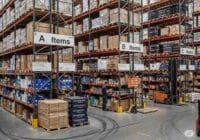Ordering too much inventory wastes money. Ordering too little risks running out of stock. In inventory management, the economic order quantity (EOQ) formula helps you find the sweet spot — the ideal order size that keeps costs down while meeting demand.
It’s not just a formula for spreadsheets. EOQ is a practical tool that businesses use to plan purchases, improve cash flow, and keep storage space under control, making it a key part of an efficient inventory management strategy.
Understanding economic order quantity (EOQ)
EOQ is the optimal number of units to order so that total inventory costs — both ordering and holding — are as low as possible.
Ordering costs are the expenses that come up every time you place an order. They include things like administrative work, delivery fees, and labor for processing incoming stock. Even small, frequent orders can add up to a large total over time.
Holding costs are the expenses of keeping inventory in storage. They cover warehouse rent, utilities, insurance, depreciation, and the cost of having your money tied up in stock instead of using it elsewhere in the business.
The goal of EOQ is to balance these two types of costs. Order too often, and your ordering costs go up. Order too much at once, and your holding costs rise. EOQ finds the point where both are minimized.
How EOQ works in inventory management
In practice, EOQ gives you two valuable pieces of information: the ideal number of units to order each time and the frequency of those orders.
If the calculation shows your EOQ is 1,250 units and you sell 10,000 units a year, that means you’ll place orders about eight times annually. This creates a predictable rhythm for reordering, which helps maintain consistent stock levels without tying up too much capital in inventory.
A predictable order cycle also supports supplier relationships. Suppliers appreciate steady, planned orders rather than unpredictable spikes. It also makes warehouse planning easier — especially if you work with Trebley’s flexible warehousing service, where you only pay for the space you actually use, and storage can scale with your needs.
EOQ formula and key variables
The basic EOQ formula is:
EOQ = √(2DS / H)
- D stands for the annual demand in units.
- S is the ordering cost per order, covering everything from administrative processing to freight charges.
- H is the holding cost per unit per year, which includes storage, insurance, and other related expenses.
The formula calculates the point where ordering costs and holding costs are perfectly balanced. The result tells you exactly how many units to order each time to minimize total inventory expenses.
Accurate numbers are crucial. If your holding cost estimate is wrong, your EOQ will be off and may cause overstocking or shortages. Trebley’s inventory management services give you precise, real-time data on storage and handling costs, helping you calculate EOQ with confidence.
Steps to calculate EOQ
1. Find annual demand (D) — Review your past sales records to see how many units you sold over the last year. If your business is new or sales fluctuate, use forecasts based on market research, seasonal patterns, and growth projections. Accurate demand figures are the foundation of a reliable EOQ calculation.
2. Determine ordering cost (S) — Add up all the costs involved in placing and receiving an order, regardless of quantity. This includes administrative work, purchase order processing, shipping fees, customs charges, and any labor needed for receiving and inspecting goods.
3. Work out holding cost (H) — Calculate how much it costs to store one unit for a year. This should include warehouse rent or fees, insurance, utilities, depreciation, security, and the opportunity cost of having capital tied up in inventory. For perishable items, factor in the cost of spoilage.
4. Apply the EOQ formula — Use the formula √(2DS / H) and plug in your numbers. This will give you the ideal number of units to order each time. The goal is to find the point where ordering costs and holding costs are balanced for maximum efficiency.
5. Use the result to set reorder quantities and plan warehouse space — Once you know the optimal order size, align your purchasing schedule accordingly. Plan your warehouse space to handle this amount comfortably, whether it’s in your own facility or with a flexible storage solution like Trebley’s pay-only-for-what-you-use warehousing.
Benefits of using EOQ
Lower inventory costs — EOQ helps you avoid ordering more than you need, which means less capital tied up in products that sit on shelves. This reduces both ordering and holding costs, freeing up resources for other parts of your business.
Better cash flow — When you’re not overstocking, more of your working capital is available for important activities like marketing, product development, or expanding into new markets. EOQ ensures you have the right stock levels without locking away money in unused inventory.
Reduced storage needs — By ordering in quantities that match demand, you avoid filling up valuable warehouse space with items that aren’t moving. This can lower your storage costs, whether you own your facility or use a pay-for-what-you-use service like Trebley’s warehousing.
Improved supplier planning — Consistent order sizes and schedules make it easier for suppliers to plan their production and deliveries. This can lead to better service, more reliable lead times, and in some cases, more favorable pricing.
Less spoilage — For businesses handling perishable goods, EOQ helps match order quantities to sales velocity. This reduces the risk of products expiring before they’re sold, protecting your margins and minimizing waste.
Supports 3PL efficiency — EOQ works best when paired with reliable logistics. Trebley can manage the storage, transport, and inventory tracking needed to keep your EOQ plan on track from order placement to final delivery, ensuring goods move efficiently through your supply chain.
Limitations and assumptions of EOQ
EOQ is based on a few assumptions. It works best when demand and lead times are constant and predictable. If your sales fluctuate heavily or your suppliers have unpredictable delivery times, the formula’s accuracy can drop.
It also doesn’t account for bulk purchase discounts unless adapted. If you can get significant savings from buying in larger quantities, you’ll need to modify the EOQ calculation to see if the discount outweighs higher holding costs.
Accurate cost data is essential. If your ordering or holding costs are off, the resulting EOQ may lead to inefficiencies. EOQ also works best for single-SKU calculations. For businesses with many SKUs, it’s best to run EOQ for each product separately and then look at the bigger operational picture.
Lastly, seasonal demand can require recalculations. Businesses that experience sharp peaks and drops in sales throughout the year should adjust EOQ seasonally to stay accurate.
Advanced EOQ models and alternatives
For more complex inventory needs, the basic EOQ formula can be adapted to suit different business scenarios.
EOQ with quantity discounts — This version accounts for bulk pricing. If suppliers offer significant discounts for larger orders, the calculation is adjusted to determine whether the savings outweigh the higher holding costs.
EOQ with backordering — In some cases, allowing customers to place orders for out-of-stock items is acceptable. This model factors in the cost of fulfilling orders late and balances it against holding and ordering costs to find the most cost-effective order size.
Stochastic EOQ — When demand is unpredictable, this model adds variability and probability into the calculation. It’s especially useful in industries with volatile sales patterns, where the basic EOQ might not provide accurate results.
Other inventory strategies can also work alongside EOQ:
Just-in-Time (JIT) — Focuses on keeping minimal inventory by ordering goods only when needed, reducing storage costs but requiring highly reliable suppliers.
Safety stock planning — Adds a buffer of extra stock to handle unexpected demand spikes or supply delays, protecting against stockouts.
Reorder point models — Triggers an order automatically when inventory levels hit a predefined threshold, often used in combination with EOQ to ensure timely replenishment.
ABC analysis — Prioritizes control over the most valuable products (A items) while applying less strict oversight to lower-value items (B and C categories).
Applying EOQ in real business operations
EOQ is flexible enough to be used in almost any industry:
Retail — Ensures store shelves are stocked to meet customer demand without tying up too much capital in slow-moving products.
Manufacturing — Keeps raw materials flowing into production lines on time, avoiding costly delays without overloading storage areas.
eCommerce — Helps balance stock levels across multiple SKUs, ensuring high-demand products are always available while preventing overstocking of less popular items.
3PL logistics — Combines EOQ planning with a reliable partner who can provide scalable storage and transportation. Trebley’s 140,000 sq ft warehouse and network of 15 transportation partners make it easy to put EOQ plans into action. Seasonal spikes, year-round consistency, or rapid scaling are all manageable with Trebley’s flexible warehousing, inventory tracking, and transport services
How Trebley supports EOQ-based inventory management
Trebley offers warehousing that adapts to your needs — you only pay for the space you use, with no long-term commitments. This flexibility aligns perfectly with EOQ, which often changes order quantities as your business evolves.
Our inventory management systems give you accurate, real-time stock data so your EOQ calculations are always based on the latest information. Our transportation services cover trucking, courier, and even rail shipments, ensuring that your order cycles stay consistent.
Through cross docking, we can move goods quickly from inbound trucks to outbound shipments, reducing holding times and keeping inventory moving efficiently. And because our capacity is scalable, you can expand or contract warehouse space as demand changes — without the headache of switching facilities.
Conclusion
EOQ is a proven method for controlling inventory costs and planning orders with precision. The formula is simple, but to make it work in the real world, you need accurate data and a reliable logistics network.
With Trebley’s warehousing, transportation, and inventory services, you can put EOQ into action without worrying about space shortages, late deliveries, or excess stock. That means more efficiency, better cash flow, and fewer headaches in your supply chain.
FAQs
What is EOQ in simple terms?
It’s the ideal order size that keeps inventory costs as low as possible while still meeting customer demand.
How do you calculate EOQ?
Use the formula √(2DS / H), where D is annual demand, S is ordering cost, and H is holding cost.
Can EOQ be used for seasonal demand?
Yes, but it works best when recalculated for each season to reflect changing demand patterns.
What’s the difference between EOQ and JIT?
EOQ keeps a calculated buffer of stock, while JIT aims to keep almost no inventory and orders only when needed.
Does EOQ work for perishable goods?
Yes, but holding costs should include spoilage risk, and order sizes may need to be smaller to match shelf life.
How often should EOQ be recalculated?
Whenever your costs or demand change significantly — at least once or twice a year for most businesses.
What role does a 3PL like Trebley play in EOQ management?
A 3PL provides the storage, transport, and inventory tracking needed to execute EOQ effectively, ensuring your calculated order quantities can be handled without delays or added costs.





